|
|
|
|
A Releasing Your Unlimited Creativity discussion topic | |
|
Copyright 2009 by K. Ferlic, All Rights Reserved | |
| RYUC Home Why free? Contact Links Programs Services Contributions List of Topics | |
|
Studying the wave nature of energy is a science and a world unto itself. Optics, music, seismology, radio, TV broadcast, are examples of sciences or disciplines that use the wave nature of energy. For years physicists looked at waves completely separate from that of a particle. Then physicists stumbled upon the phenomenon that energy can be a wave or a particle depending under the conditions in which the energy is observed. Experiments could be constructed to show the particle nature of waves and the wave nature of particle. But, nevertheless, given the human body, what we experience as wave works one way and what we experience as a particle works another way. Although everything is energy consciousness, any particular environment will only reveal some of its characteristics and attributes. The physical plane emphasizes the localized energy aspects and localized consciousness aspects of energy consciousness as opposed to its wave nature. But that does not mean the wave nature is not observable in the physical plane. Rather we just need to change our focus. We can expect that there are attributes of energy consciousness that we experience in the physical plane and there will be attributes that the physical plane will be incapable of expressing. In this regard, we can fully expect a world what is traditionally called "spirit" or non physical reality that seems separate and totally unexplainable and different that what is experienced in the physical plane. However that does not mean the realm of spirit or where non physically observed attributes are readily expressed and the world of the physical are in any way separate. They are one and the same and exist simultaneously together. It is just the nature of the observation and the environment of observation is different. We only need to change how we observe to see them. We change how we observe by how we focus our attention and awareness. That, in turn, is determined by our belief structure. In understanding the concept of the wave, we open the door to understanding the unseen realms of Creation. What is provided here is a basic discussion of the concept of a wave and the wave nature of energy Basic Principles of Waves The simplest wave form that almost everyone has experienced is probably the ripple on the surface on a pond or pool of water. If you don’t recall such an experience, all you need to do is find a calm pool of water, throw or drop a small pebble into the pond and watch the ripple propagate outward from the location the pebble entered the water. What happens here is that the pebble disturbs the surface of the water and the ripple is the energy of that disturbance being dissipated through out the surface of the water. A wave is only the propagation of the energy of a disturbance. A wave is really not so much a thing as a process. It is the process of transferring energy. You can’t really grab hold of the wave the way you think of grabbing holding a particle. The wave is motion and it represents energy in motion. One can create a standing wave which is a particular way of how we can appear to "hold" a wave in form. But, we must have a very specific set of limits and barriers to "hold" the energy in a standing wave pattern. Otherwise, if the boundary conditions are not correct, the energy dissipates. As the energy dissipates, the wave motion seems to die out. In our pond of water, the ripple will move back and forth across the surface of the pond, bouncing off the boundaries of the pond until all the energy of the disturbance is absorbed. The energy is absorbed by the friction or resistance to the wave motion as a result of the individual atoms or molecules of the medium being held to each other through some type of physical or chemical bonding. If there were no resistance to absorb the energy, the wave would continue indefinitely bouncing back and forth between the barriers retaining pool of water going on forever and ever.
Waves can be produced in any medium and although various waves will have different forms of expression the wave phenomenology itself, that process of transferring the energy, will essentially remained unchanged. For example, there are transverse waves were the disturbance causes the medium to vibrate up and down and is the longitudinal wave where the disturbance causes a in ward and outward motion of the medium. Some wave will only exist where their is a physical medium to vibrate. For example, sound is a result of vibrating molecules, so if there no material to vibrate there is no sound. Consequently, sound does not travel though a vacuum. Similarly other waves, like the electromagnetic waves produced by accelerating or pushing electrons up and down antennae need no physical medium and will exist in a vacuum. This point also brings up the fact that waves will travel differently in different materials. Whether the wave is a sound wave or an electromagnetic wave the various properties of the material like density, and the elemental composition, and other defining properties will cause the waves to manifest or be seen different, or sometimes to not exist at all. What also is interesting is that rarely in nature is a monochromatic wave or a wave of a single frequency or vibration produced by the disturbance. Usually wave production will result in a spectrum of waves, more that one type of wave, being produced by the single disturbance and this spectrum of energy changes as it passes through material because the material will response differently to each different wave vibration. Varying the material the particular type of wave is going to traverse or be reflected from allow one to develop stealth technology, sound proofing technology, electronic sound reproduction and other wave manipulation abilities. However, in all of these cases and manipulation of waves there are a few basic principles that provide for a wide range of understanding. By observing wave, and the spectrum that is produced by the disturbance in the formation of the wave, information is available about the nature and type of disturbance. Knowing something about the material the wave travels through and with which it will interact, information about the spectrum and hence about the disturbance is gained. So in effect, waves carry information or can be seen as presenting information about the nature of the disturbance. After reviewing these basic principles, we can then see how the concepts of waves and be readily applied to many aspects of how consciousness manifests itself in many analogous ways. Basic Terminology and Concepts of Waves All waves can be characterized by unique number called the frequency. The frequency is just the number of waves or disturbances emitted by the source in a unit of time or number of waves passing a point per unit time. For example, Middle C on the piano has a frequency of 256 vibrations per second. This means that either the source causing the vibrations pushes and pull 256 times per second or as the wave travels past you that you hear causing the sounding to vibrates at 256 times per second. [An aside: When a piano hammer strikes Middle C, the hammer does not hit the string 256 times per second. The string is hit once, and because of the string’s length and the tension in the string, vibrated a rate of 256 time per second pushing the surrounding air at this rate] Similarly, the frequency of vibration of blue light is on the order of 6.6 million billion time per second (ten to the fifteenth power or 1015). The frequency of the wave will always remain the same and there are an infinite number of frequencies possible.
The wave velocity is just how fast the wave moves in a given direction or the wave’s speed in a given direction. Waves are vector quantities and do have directions and that direction is representative of the direction of the energy flow and the direction in which the energy is being transferred. Since the velocity of a wave is dependent on its speed, the speed portion of the velocity vector will also change in a give material but the direction of its motion will remain unchanged unless the wave is reflected or refracted by the material. Refraction refers to the wave direction still being in a forward direction but bent from it original path. Reflection refers to the fact that the direction of the wave is in a reversed direction. Another way of saying this for those who like mathematics, refraction is a wave the is scattered less that 180 degrees from its original direction and reflection is a wave scattered more than 180 degrees. In physical materials, like the material in which sound waves are produced, the energy of the wave exists in the compression and expansion with subsequent vibration of the atoms or molecules of the material. In the expansion phase the energy is seen as a kinetic energy or increased movement of the atoms or molecules. In the compression phase, the atoms tend to get squeezed together and the energy gets converted from kinetic energy, or this energy of movement, into potential energy, or stored energy. Potential energy can be viewed as that energy being stored in squeezing the atoms close together or held in a close arrangement when they prefer to push apart.
To create a sine wave from the motion of a pendulum, we need to take a pencil and move it up and down in a constant rhythm following the pendulum on a piece of paper. We then need to pull the paper at a constant rate left or right. The resulting trace of the movement of the pendulum which is drawn will be a rough sine wave. However, if we could attach the pencil to the pendulum and allow the pendulum to swing cross a piece of paper pulled at a constant rate to trace it path, we would find the traditional wave pattern as in Figure "Pendulum Trace" and the trace would be much more accurate than trying to follow the movement of the pendulum with our hand.
As we see in the plots of the kinetic energy or potential energy, a wave motion or trace is in fact produced by the disturbance. All waves have a similar expansion and collapsing of the transfer of the energy. With electromagnetic waves like radio waves or light waves traveling through a vacuum such a space, where there is no material to vibrate, the energy of the wave is being stored in the expansion and collapsing of the electric and magnetic fields that permeate all of space. Electric and magnetic fields are the fields that are created by the electric and magnetic properties of matter in an analogous way that large planets and celestial bodies create gravitation fields
Related topics
The Password Protected Area provides access to all currently posted (click for current loading) Releasing Your Unlimited Creativity related discussion files and applications. |
|
|
RYUC Home Why free? Contact Links Programs Services Contributions List of Topics | |

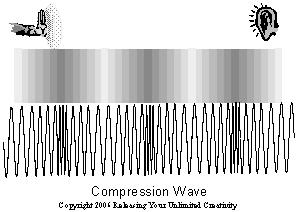 Wave are a result of a disturbance where there is some type of
pushing in or an insertion, and a pull out or withdrawal. As seen in
the Figure "Compression Wave" the pushing is a thrust of
energy and that thrust disturbs the medium into which the energy is
inserted. That energy is then transferred to the surrounding medium.
When the withdrawal occurs, the cycle begins. It is the cycle of the
inward thrust and outward pull. Each thrust by the object into the
medium causes energy to be inserted. The thrust can be a one time
thrust like that of a pebble thrusting through the surface of the
water or it could be the hammer of a piano key striking the string.
In this case there is a transient wave that is produced but dies you
as soon as the thrusting motion is stopped. Alternatively, it an be
a continual and repetitive thrust like a bow string being slowly
pulled across a string of cello producing a sustained sound as long
the bow is continually pulled or the cyclic noise emanating from an
internal combustion engine like a gasoline powered lawn mower or a
car engine were each cycle of the engine produces a expulsion of
burn gases into the atmosphere producing a particular characteristic
exhaust noise of the engine.
Wave are a result of a disturbance where there is some type of
pushing in or an insertion, and a pull out or withdrawal. As seen in
the Figure "Compression Wave" the pushing is a thrust of
energy and that thrust disturbs the medium into which the energy is
inserted. That energy is then transferred to the surrounding medium.
When the withdrawal occurs, the cycle begins. It is the cycle of the
inward thrust and outward pull. Each thrust by the object into the
medium causes energy to be inserted. The thrust can be a one time
thrust like that of a pebble thrusting through the surface of the
water or it could be the hammer of a piano key striking the string.
In this case there is a transient wave that is produced but dies you
as soon as the thrusting motion is stopped. Alternatively, it an be
a continual and repetitive thrust like a bow string being slowly
pulled across a string of cello producing a sustained sound as long
the bow is continually pulled or the cyclic noise emanating from an
internal combustion engine like a gasoline powered lawn mower or a
car engine were each cycle of the engine produces a expulsion of
burn gases into the atmosphere producing a particular characteristic
exhaust noise of the engine. 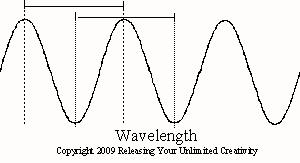 Wavelength is another unique number that describes the wave and
is the distance from one wave crest to the next or from trough to
trough as in the Figure "Wavelength." Although the wavelength
will uniquely describe the wave, it can change depending on the on
the medium in which it is passing through. Wavelength times the
frequency of the wave is the speed of the wave and a such, since the
frequency of the wave is constant, the speed of a wave will also
change depending on the medium because the wavelength can change. In
any given medium, waves of different frequencies will travel at
different speeds through the medium. Higher frequency waves tend to
move faster than the lower frequency waves. As such if a very broad
spectrum of frequencies enters a material, the spectrum will shift
as it traverses the materials. A spectrum shift means the ratio and
proportions of the various frequencies relative to each other will
shift. This difference in speed for different frequency is what
causes such phenomenon such as the rainbow or a glass prism
splitting the white light into its various frequencies.
Wavelength is another unique number that describes the wave and
is the distance from one wave crest to the next or from trough to
trough as in the Figure "Wavelength." Although the wavelength
will uniquely describe the wave, it can change depending on the on
the medium in which it is passing through. Wavelength times the
frequency of the wave is the speed of the wave and a such, since the
frequency of the wave is constant, the speed of a wave will also
change depending on the medium because the wavelength can change. In
any given medium, waves of different frequencies will travel at
different speeds through the medium. Higher frequency waves tend to
move faster than the lower frequency waves. As such if a very broad
spectrum of frequencies enters a material, the spectrum will shift
as it traverses the materials. A spectrum shift means the ratio and
proportions of the various frequencies relative to each other will
shift. This difference in speed for different frequency is what
causes such phenomenon such as the rainbow or a glass prism
splitting the white light into its various frequencies. 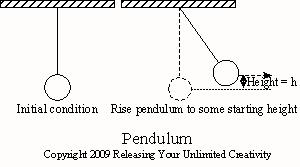 Think of a pendulum hanging on a string. If we pull the pendulum
horizontally up to some height, energy is stored in the pendulum.
Energy is stored in that it is being pulled to return to its resting
position, its lowest position, but it is being held up against its
"preferred" motion as in the Figure "Pendulum." In letting it
drop it will start from zero speed gaining speed as it falls. As it
swings down at the bottom of the arc it gains maximum speed and the
slowly loses this speed as the pendulum starts up the other side. As
it rises the pendulum converts it kinetic energy of movement into
the stored potential energy of gravity represented by the pendulums
height above it lowest point. At reaching it maximum height, the
pendulum stop since it no longer has any kinetic energy and it has
reached it greatest potential energy. Here the process reverses and
the pendulum begins to fall starting the entire cycle in reverse
order.
Think of a pendulum hanging on a string. If we pull the pendulum
horizontally up to some height, energy is stored in the pendulum.
Energy is stored in that it is being pulled to return to its resting
position, its lowest position, but it is being held up against its
"preferred" motion as in the Figure "Pendulum." In letting it
drop it will start from zero speed gaining speed as it falls. As it
swings down at the bottom of the arc it gains maximum speed and the
slowly loses this speed as the pendulum starts up the other side. As
it rises the pendulum converts it kinetic energy of movement into
the stored potential energy of gravity represented by the pendulums
height above it lowest point. At reaching it maximum height, the
pendulum stop since it no longer has any kinetic energy and it has
reached it greatest potential energy. Here the process reverses and
the pendulum begins to fall starting the entire cycle in reverse
order. 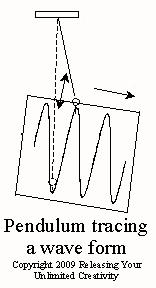 Any vibration as that represented in the pendulum moving back and
forth or a ripple on a pond moving up and down can be represented
linearly as an oscillation up and down or back and forth. The
resulting form of the oscillation is a sine wave. The sine wave is a way of representing an oscillation
or a frequency linearly in time.
Any vibration as that represented in the pendulum moving back and
forth or a ripple on a pond moving up and down can be represented
linearly as an oscillation up and down or back and forth. The
resulting form of the oscillation is a sine wave. The sine wave is a way of representing an oscillation
or a frequency linearly in time. 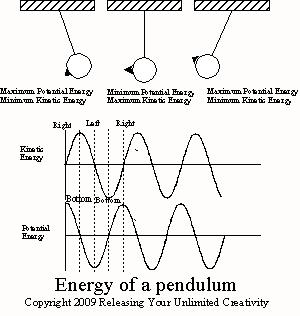 If we plot the kinetic energy versus the height of the pendulum
as in the Figure "Energy of a Pendulum," we see that we
generate the typical wave as the kinetic energy expands and
contacts. The potential energy is the exact opposite of the kinetic
energy since the potential energy grows as the kinetic energy
decreases and vice versa. The curve or wave
plotted in the Figure
"Energy of a Pendulum," just demonstrates the process of
converting or transferring the energy between the kinetic and
potential of the pendulum. However, the total energy of the system,
kinetic energy plus the potential energy, at any point along the
pendulum’s path is constant and equal to that energy introduced by
the disturbance. In this case, the disturbance was raising the
pendulum horizontally above its resting position.
If we plot the kinetic energy versus the height of the pendulum
as in the Figure "Energy of a Pendulum," we see that we
generate the typical wave as the kinetic energy expands and
contacts. The potential energy is the exact opposite of the kinetic
energy since the potential energy grows as the kinetic energy
decreases and vice versa. The curve or wave
plotted in the Figure
"Energy of a Pendulum," just demonstrates the process of
converting or transferring the energy between the kinetic and
potential of the pendulum. However, the total energy of the system,
kinetic energy plus the potential energy, at any point along the
pendulum’s path is constant and equal to that energy introduced by
the disturbance. In this case, the disturbance was raising the
pendulum horizontally above its resting position.